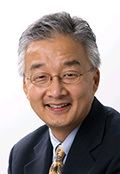Nationality USA Name Luke Lee | Role Professor | |
 | ||
Known for Photonic RNA Switch, Photonic Gene Circuits Notable awards 2003 National Science Foundation Career Award2005 Lester John and Lynne Dewar Lloyd Distinguished Professorship2009 IEEE The William J. Morlock Award2010 Arnold and Barbara Silverman Distinguished Professorship2010 The Ho-Am Prize Education University of California, Berkeley (2000) People also search for Oscar J. Abilez, Frank B Myers, Christopher K. Zarins | ||
Luke Pyungse Lee (born in March 22, 1959) is a Tan Chin Tuan Centennial Professor, founding director of the Biomedical Institute for Global Health Research & Technology (BIGHEART), and Associate President (International Research and Innovation) at the National University of Singapore. Lee is also the Arnold and Barbara Silverman Distinguished Professor of Bioengineering, Biophysics, Electrical Engineering and Computer Science, at University of California, Berkeley.
Contents
Lee has over 250 peer-reviewed publications and over 31 international patents filed. He is a world-renowned pioneer in bionanophotonics, plasmonic resonant energy transfer (PRET), rapid photonic PCR, optofluidics, microfluidics for quantitative life sciences, and integrated molecular diagnostics systems. He was elected Fellow of the Royal Society of Chemistry in 2010 and the American Institute of Medical and Biological Engineering in 2012. Lee received the 2009 IEEE William J. Morlock Award in 2009 and the 2010 Ho-Am Prize for his discovery of PRET and the development of quantum nanobiophotonics for optical gene regulations and molecular imaging (photonic RNA switch and gene circuit). His current research interests are quantum electron transfers in living organisms, molecular diagnostics of infectious and neurodegenerative diseases, and in vitro neurogenesis, with a focus both on studying fundamental quantum nanobiology and on solving ill-defined problems of global healthcare.
Education & Career
Luke P. Lee was born the youngest of three boys in the family of a poet father, Sang Ro Lee and a midwife, Bok Soon Ha. After the death of his father, he immigrated to America with his mother and brother in 1976. Lee spent his life in Seoul attending up to 11th grade of high school. After he moved to the US, he attended Wasson high school in Colorado Springs, Colorado for 12th grade. He received a BA in Biophysics from the University of California, Berkeley in 1996 and received his PhD in Applied Science and Technology (Applied Physics: major & Bioengineering: minor) from the University of California, Berkeley in 2000.
In 1999, he became an assistant professor of bioengineering at the University of California, Berkeley. In 2005, he became a full professor and the Lester John and Lynne Dewar Lloyd Distinguished professor of bioengineering and a professor of biophysics at Berkeley. He also served as the Chair Professor in Systems Nanobiology at the Swiss Federal Institute of Technology (ETH, Zürich) from 2006 to 2007. Lee also has a joint appointment in the Department of Electrical Engineering and Computer Science at Berkeley. He has been the co-director of the Berkeley Sensor & Actuator Center since 1999. He became the Arnold and Barbara Silverman Distinguished Professor in 2010 and reappointed again 2015.
Prior to his academic career, he had over ten years of extensive R&D and industrial experience in integrated optoelectronics and superconducting electronics. In the late 80s, as a member of technical staff at TRW Inc, he worked on laser holography, quantum-well surface emitting laser, Nb-based Josephson tunnel junctions, and superconducting quantum interference device (SQUID) electronics. In the early 90’s, he worked on high-temperature SQUID magnetometers, Josephson junction devices, and biomagnetic sensors at Conductus Inc.
Selected Publications (selected from over 250 peer-reviewed publications)
- Luke P. Lee and Robert Szema, “Inspirations from Biological Optics for Advanced Photonic Systems”, Science, vol. 310, no. 5751, 1148 – 1150(2005).
- Cristian Ionescu-Zanetti, Robin M. Shaw, Jeonggi Seo, Yuh-Nung Jan, Lily Y. Jan, and Luke P. Lee, “Mammalian Electrophysiology on a Microfluidic Platform”, Proc. Natl. Acad. Sci. USA, vol. 102, no. 26, 9112-9117(2005).
- Ki-Hun Jeong, Jaeyoun Kim, Luke P. Lee, “Biologically Inspired Artificial Compound Eyes”, Science, vol. 312, p. 557-561(2006).
- Gang L. Liu, Jaeyoun Kim, Yu Lu, and Luke P. Lee, “Optofluidic Control using Photothermal Nanoparticles”, Nature Materials, 5, 27-32(2006).
- Gang L. Liu, Yadong Yin, Siri Kunchakarra, Bipasha Mukherjee, Daniele Gerion, Stephen D. Jett, David G. Bear, Joe W. Gray, A. Paul Alivisatos, Luke P. Lee, and Fanqing Frank Chen, "A nanoplasmonic molecular ruler for measuring nuclease activity and DNA footprinting”, Nature Nanotechnology, 1, 47-52(2006).
- Gang Logan Liu, Yi-Tao Long, Yeonho Choi, Taewook Kang and Luke P. Lee, “Quantized Plasmon Quenching Dips Nanospectroscopy via Plasmon Resonance Energy Transfer”, Nature Methods, 4, 1015-1017(2007).
- Yeonho Choi, Younggeun Park, Taewook Kang, and Luke P. Lee, "Selective and sensitive detection of metal ions by plasmonic resonance energy transfer-based nanospectroscopy”, Nature Nanotechnology, 4, 742-746(2009).
- Sung Sik Lee, Ima Avalos Vizcarra, Daphne H. E. W. Huberts, Luke P. Lee, and Matthias Heinemann, Whole Lifespan Microscopic Observation of Budding Yeast Aging Through a Microfluidic Dissection Platform, Proc. Natl. Acad. Sci. USA, 109(13), pp. 4916–4920(2012).
- Ruoxue Yan, Ji-Ho Park, Yeonho Choi, Chul-Joon Heo, Seung-Man Yang, Luke P. Lee, and Peidong Yang, Nanowire-based single-cell endoscopy, Nature Nanotechnology, 7(3), pp. 191–196(2012).
